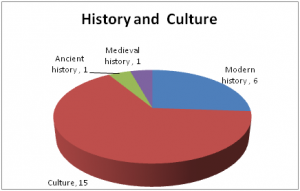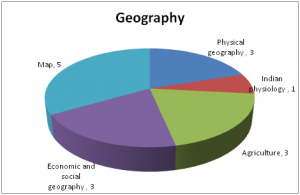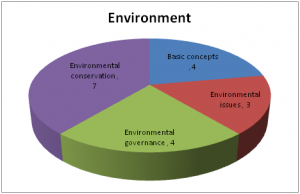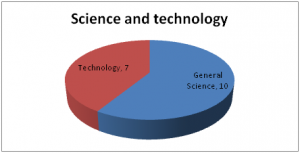GS for PT is tough; most of the students are worried about it, as there is no fixed length and breath. However, at the same time they also show traits of careless attitude by carrying loose mode of preparation. Aspirants generally go through N.C.E.R.T. books and some crash materials. N.C.E.R.T. books are certainly important, but only to begin with. You cannot depend solely on these books. Even we use to categorize the PT questions for the sake of our convenience with a purpose of decoding the trend. But loose and general categorization does not help always.
As the stakes have gone high, every single mark matters in Civil Services Exam. Earlier ever if, one scored even 45-50% in written examination, he/she could be confident to get a place in final selection. However, this year’s preliminary examination will be a different game altogether. A tough examination became tougher, as one has to attempt only the GS. CSAT is now qualifying in nature.
A tough question for this year’s Prelim is – what is likely to be the cut-off? This topic always has been a subject of high speculation and gossip. This year too aspirants are worried for the same. A frequent question, I face is – what would be safe marks in the PT ? Well, if we look at the previous years’ scoring pattern, one can easily notice that larger count of student scored approximately 110 in GS. However CSAT was a deciding factor then. But under the new pattern GS has become the only factor.
GS for PT is tough; most of the students are worried about it, as there is no fixed length and breath. However, at the same time they also show traits of careless attitude by carrying loose mode of preparation. Aspirants generally go through N.C.E.R.T. books and some crash materials. N.C.E.R.T. books are certainly important, but only to begin with. You cannot depend solely on these books. Even we use to categorize the PT questions for the sake of our convenience with a purpose of decoding the trend. But loose and general categorization does not help always.
For example: Analyze the question of last year’s Prelims and try to encircle total number of questions asked from Geography. In the first glimpse you may find that approximately 20 question were asked. But a careful scrutiny will give you another picture. 4 questions are from physical geography and related areas and rest questions are of very general nature and this does not demand to go through very popular bulky books. On the basis of such observation you may find that there are 30-35 areas where UPSC focuses most of the time, however, weights of the subject related question may vary year to year. To make your preparation more focused for this year’s PT, I am trying to figure out important areas where UPSC focuses all the time. You can also verify it by going through last few years questions.
The lists of areas are as follows:
1. Biodiversity and conservation strategy
2. Environmental problems (special focus on climate change, pollution, etc)
3. Environment and global initiative issues
4. Biotechnology
5. Nutrition, Health and diseases
6. Agriculture
7. Water resource and management
8. Infrastructure
9. Energy
10. Forest
11. Welfare schemes and programmes
12. Inclusion issues and initiatives
13. Recent development in the field of Space, Defence and IT
14. Culture
15. Buddhism and Jainism
16. Issues related to governance
17. Statutory and regulatory bodies
18. Parliament – functions, responsibilities and issues
19. Preamble, Fundamental Rights, DPSP and Fundamental Duties
20. Amendments
21. Constitutional Bodies
22. Indian Constitution: significant provisions and basic structure
23. Local governance
24. Demography
25. Industry and Trade
26. Monetary and Fiscal Policy
27. National income concept
28. Banking
29. India Year Book
• Land and the people
• National Symbols
• Agriculture
• Culture and Tourism
• Basic education Data
• Defence
• Education
• Environment
• Food and Civil Supplies
• Rural and Urban development
• Scientific and technological developments
• A leap forward – New Initiatives of the Government
30. Economic Survey
• State of the Economy: An overview
• Prices, Agriculture and Food Management
• Climate Change and Sustainable Development
• Social Infrastructure, Employment, and Human Development
• ‘Wiping every tear from every eye’: the JAM Number Trinity Solution
• What to Make in India? Manufacturing or Services?
• A National Market for Agricultural Commodities- Some Issues and the Way Forward
• From Carbon Subsidy to Carbon Tax: India’s Green Actions
• The Fourteenth Finance Commission (FFC) – Implications for Fiscal Federalism in India?
Click Here to Download Demography Notes
PRELIMS 2014 PAPER ANALYSIS: GENERAL STUDIES
The Preliminary Examination consists of two papers of Objective type (multiple choice questions) and carry a maximum of 400 marks. This examination is meant to serve as a screening test only; the marks obtained in the Preliminary Examination by the candidates who are declared qualified for admission to the Main Examination will not be counted for determining their final order of merit. The number of candidates to be admitted to the Main Examination will be about twelve to thirteen times the total approximate number of vacancies to be filled in the year in the various Services and Posts. Only those candidates who are declared by the Commission to have qualified in the Preliminary Examination in the year will be eligible for admission to the Main Examination of that year provided they are otherwise eligible for admission to the Main Examination.
Here, we are analyzing the trend of Paper 1 i.e. General Studies to provide a broad overview about the topics covered in the paper to the aspirants.
The broad subject-wise question distribution is as follows:
| S. No. | Subject | Number of question asked |
| 1 | History and culture | 20 |
| 2 | Geography | 14 |
| 3 | Polity | 14 |
| 4 | Economy | 10 |
| 5 | Environment | 18 |
| 6 | Science and technology | 16 |
| 7 | Current affairs | 8 |
Now, the topic-wise question distribution is as follows:
History and culture
• Modern history 6
• Culture 15
• Ancient history 1
• Medieval history 1
Geography
• Physical geography 3
• Indian physiology 1
• Agriculture 3
• Economic and social geography 3
• Map 5
Environment
• Basic concepts 4
• Environmental issues 3
• Environmental governance 4
• Environmental conservation 7
Science and technology
• General science 10
• Technology 7
Basic Economy
• Banking – 4
• Finance – 1
• Fiscal – 3
• International trade and data – 2
Basic Polity
• Based on Articles of Constitution – 2
• Organs of Government – 7
• Organizations – 2
READ ALSO: CURRENT AFFAIRS: THE REAL GAME CHANGER FOR PT 15′
BY MANOJ K. JHA






